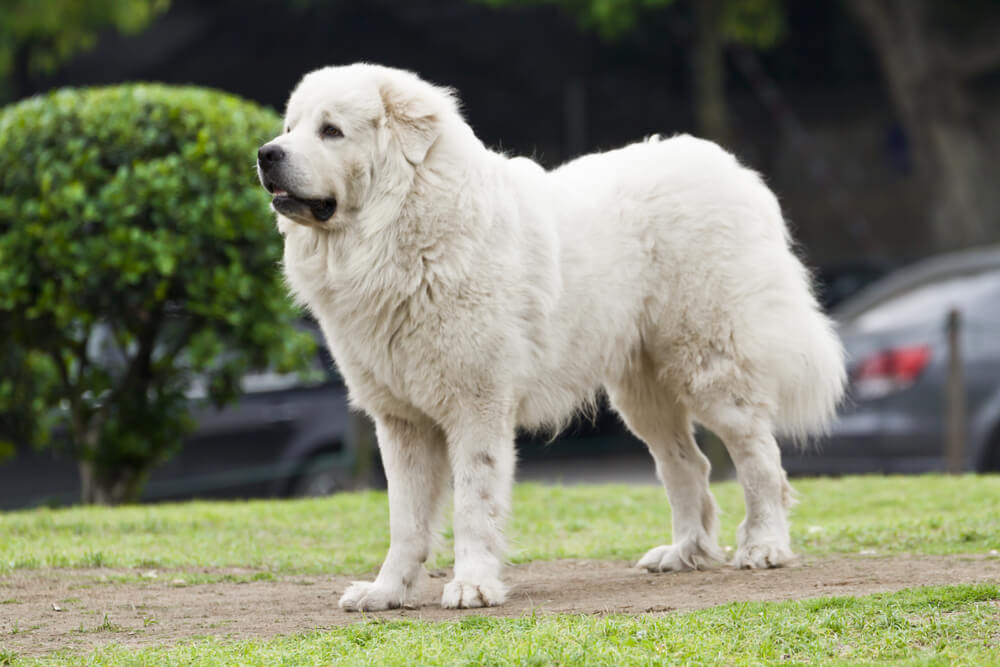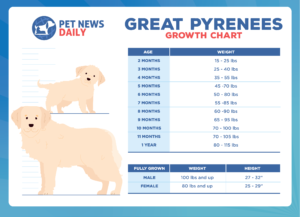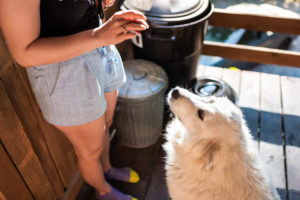If you’re the proud owner of a new Great Pyrenees puppy, you know he’s going to get big. The question is: just how big? We consulted with our veterinarian, Dr. Jennifer Coates, who reviewed and approved data about puppy weights and sizes, which we then used to create a convenient Great Pyrenees growth chart. You can use this as a reference to see how your puppy compares to the average.
The chart shows you a Great Pyrenees’ monthly average weight range during the growing phase. You can also refer to the puppy weight calculator to get an idea of how big your puppy is likely to get.
In This Article
Great Pyrenees Growth Chart
- 1 year: 80-115 pounds
- Fully grown males: 100 pounds and up, 27-32 inches
- Fully grown females: 85 pounds and up, 25-29 inches
Text Transcript of the Great Pyrenees Growth Chart
| Great Pyrenees – Age | Weight | Height |
|---|---|---|
| 2 months 3 months 4 months 5 months 6 months 7 months 8 months 9 months 10 months 11 months 1 year |
15-25 pounds 25-40 pounds 35-55 pounds 45-70 pounds 50-80 pounds 55-85 pounds 60-90 pounds 65-95 pounds 70-100 pounds 70-105 pounds 80-115 pounds |
27-32 inches |
About Great Pyrenees
A steadfast guardian is what you get when you bring home a Great Pyrenees. Large, strong, and powerful, this working dog makes a mellow companion and vigilant protector for the home and family.
Often described as “majestic,” they typically have a lush weatherproof coat that is all white, though they can also be white with gray, tan, or reddish-brown markings.1
Originally bred to work with peasant shepherds as herding dogs in the Pyrenees Mountains (between France and Spain), the Great Pyrenees was tasked with protecting sheep from wolves, bears, and even livestock rustlers.
They learned to be patient watchers capable of springing into action whenever danger threatened.
This is an old breed, believed to have arrived in the Pyrenean Mountains with their shepherds around the year 3,000 B.C. Fossils of them have been found in the region and dated to between 1,800 B.C. and 1,000 B.C.
According to the American Kennel Club (AKC), experts “think the breed probably evolved from white mountain dogs that originated in Asia Minor as many as 11,000 years ago.”2
What Are the Growth Stages of a Great Pyrenees?
Through the first year of her life, your Great Pyrenees puppy will go through many growth periods. Your job is to watch to see that she reaches her developmental milestones when she should.
Birth to Two Weeks
Between birth and two weeks, your puppy will be at her most helpless. She is blind and deaf and completely reliant on her mother for survival. At two weeks old, she’ll open her eyes and begin to hear sounds. By one month of age, she will have gained the use of her senses and will be playing and interacting with her litter mates.
Two Months to Three Months
By two months of age, your puppy will be ready to be weaned from her mother so she can go home with you. At this point, feeding and nutrition become very important. It’s best to feed your puppy three meals a day, with the portion sizes changing as she grows. You can also start teaching her basic commands like “sit” and “down,” and start house and obedience training.
Keep in mind that this breed likes to bark. They are naturally protective, so they often bark at everything new to them. Expose them regularly to new people, places, and environments to help them learn about what is “okay” and not a threat.
Three Months to Four Months
At three months old, your puppy will have gained quite a bit of weight. Males weigh between 30-40 pounds and females 25-35 pounds. This is a good time to train your puppy to walk on a leash. Don’t let her pull! You may be able to handle that now, but when she gets to her full adult height it will be much more difficult. Check with a trainer if needed.
This is also a good time to get your dog used to grooming. Daily brushing will help to keep her coat in good shape while keeping shedding to a minimum.
Four Months to Six Months
Between four and five months, your puppy will become a lot more playful. She should be positively settled with you in your home, but you will need to continue regular obedience training and socialization. Daily play and exercise times are critical to helping her manage her energy.
Six Months to Nine Months
At six months, your Great Pyrenees may start showing signs of aggression as she develops physical strength. She will be taller and heavier and may be asking for a lot of exercise. Since she is still growing, don’t overexert her, as this can injure her bones and cause joint problems later in life. Instead, break up her exercise into several smaller sessions.
She needs to be kept mentally stimulated so she doesn’t get herself into trouble. Provide her with plenty of chew toys and daily walks. Between seven and eight months, she should be doing well in her daily routine with you, and you can start taking her on longer walks. You can reduce her mealtimes to two a day, but avoid long runs on the pavement as her bones are still developing.
Nine Months to Twelve Months
Around nine months old, your Great Pyrenees will be close to her final height and should start to behave more maturely. As long as you’ve been consistent in her training, she’ll be listening to you more. Between 10 and 12 months, you can take her for longer walks and even hikes. On her one-year birthday, your dog is nearly full grown, though you can expect her to continue filling out for another 6-12 months.
Tips on Great Pyrenees Nutrition for Optimal Growth
Large breed dogs experience rapid growth in the first few months of their life, so proper nutrition is critical. You want your puppy to get all the nutrients he needs, but you also don’t want him to grow too fast. Uncontrolled growth (that leads to overweight) can increase the risk that your dog will develop joint problems like hip dysplasia later in life.
All high-quality kibble dog foods specifically designed for large-breed puppies have the optimum balance of nutrients key to controlling bone growth. Avoid foods labeled “for all sizes” as these will not be appropriate for your Great Pyrenees.
Your puppy will have a large muscle mass, so he’ll need a high protein level of 26 percent or so from real meat sources like beef, chicken, fish, and lamb. Fat content should be 8 percent or higher while he’s growing and should come from salmon oils and chicken fat, which supports bone growth, a healthy coat, and brain and eye function.
Break up the feedings when your puppy is small—three or four times a day.
The Great Pyrenees is prone to bloat, so small meals are best. So-called “free feeding” is not a good idea (leaving food down all the time) as if left to their own devices, your puppy may suffer from bloating which can escalate to a serious issue.
This is a large dog, but once fully grown, he has a slow metabolism, so he may not need as much food as you think. Once he settles into his adult weight, you can switch to adult food to keep him healthy.
Maintaining a Healthy Weight In Your Great Pyrenees
With a Great Pyrenees, it can be challenging to determine if he is overweight or underweight just by looking at him. The large size and body build can trick the untrained eye.
The great Pyrenees can be underweight, particularly if he’s not getting the proper nutrition. Illness and genetics can also cause weight loss. Being overweight is also possible, particularly once your dog reaches adulthood.
To determine how your dog is doing, use the “touch method.” Feel along your dog’s ribs, spinal column, and hip bones by pressing gently against his coat. If you can easily feel the bones, your dog is underweight. The bones should have a thin covering of muscle and fat if your dog is the right weight.
Another good way to accurately estimate your dog’s weight is to get him wet! Soak him down for a bath. Then you can observe his real figure. When looking at your dog from the top, you should be able to see an hourglass body shape with a marked tuck at the waist. If you don’t see a waist, your dog may be overweight. The World Small Animal Veterinary Association (WSAVA) offers some helpful illustrations of proper body condition.
If you notice problems with weight, check with your veterinarian. Maintaining a healthy weight can go a long way in making sure your Great Pyrenees has a long and enjoyable life.
How Big Do Great Pyrenees Get?
The AKC notes that an adult male Great Pyrenees will weigh 100 pounds or more, and a female 85 pounds or more.
While your dog is still a puppy, there are a few ways you can estimate what she may weigh as an adult. Start with her sex. As with many other animals, males are typically larger than females.3
Next, consider your puppy’s age. Most will need at least one year to reach close to their adult size. As long as your puppy is younger than that, she is still growing.
If you purchased your dog from a breeder, ask them for information about your puppy’s parents. Genetics plays a large role in height and weight. Your female puppy will likely grow to be a size similar to her mother, and your male is likely to look more like his father.
Check your puppy’s paws too. Oversized paws are a classic feature that indicates your puppy is still growing.
Another way to estimate your puppy’s final growth weight is to use this simple formula:4
(Current weight/Age in weeks) x 52.
For example, if your pup is 25 pounds at 16 weeks of age, the formula would look like this:
- (25/16) = 1.57 (rounded up)
- 1.57 x 52 = 82 (rounded up)
The best time to check your Great Pyrenees with this formula is when they reach about 16 weeks of age.
When Do Great Pyreneese Stop Growing?
As a large-sized breed, your Great Pyrenees will take longer to reach his full weight than a smaller breed. At one year, he will be close to his final height, but you can expect him to continue filling out with muscle for at least another year. This is when his chest will get broader and his neck will thicken, while his other muscles become larger and more defined.
Things That Affect Growth
Great Pyrenees are prone to certain genetic diseases and conditions.5 These include the following:
- Hip and elbow dysplasia
- Bloat and digestive tortion (stomach twisting)
- Certain types of cancer, including osteosarcoma (bone cancer)
- Heart disease
Most of these won’t affect your puppy’s growth, but some can. The vulnerability to bloat, for instance, is why it’s best to feed your puppy three to four meals a day. Smaller meals reduce the likelihood of bloating.
Good nutrition is also key to optimal growth. Dog foods that aren’t designed for large breeds or that lack real sources of protein will not give your puppy the nutrients he needs. Such foods may also contribute to accelerated growth, which can increase the risk of joint problems later in life.
Overfeeding can also be damaging and may increase the risk of your dog developing osteochondritis dissecans or OCD. This is a condition in which the puppy grows too quickly and the cartilage in her joints doesn’t attach properly to the bones. Surgery may be required to fix the problem. Far better to stick to the recommended growth rate and not overfeed.
Spaying or neutering your puppy may also affect growth if it is done too early. Though essential to avoiding unwanted puppies and even diseases like cancer, when performed too soon it can negatively affect bone and joint growth. Check with your veterinarian to determine the best time.
Exercise helps with a puppy’s growth and development, but it’s wise to be cautious about exercising too much too early, particularly before the age of six months. Long exercise periods on hard surfaces (like pavement or asphalt) can impact the formation of joints, ligaments, tendons, and muscles, leading to problems later on.
Infections with intestinal parasites like hookworms can also affect your puppy’s growth. If you notice that he doesn’t seem to be gaining weight like he should check with your vet about a potential deworming treatment.
Great Pyrenees Weight Calculator
PUPPY WEIGHT CALCULATOR
Frequently Asked Questions
A six-month-old female great Pyrenees will range from 50-60 pounds. A male will weigh between 70-80 pounds.
When your Great Pyrenees reaches two years of age, you can consider him to be fully grown. Before that, he’s still developing muscle and bone. By one year of age, however, he will be close to his final height and weight, and will simply be filling out after that.
By 10 months of age, your male Great Pyrenees should weigh between 90-100 pounds, while your female will be between 70-85 pounds.
Most Great Pyrenees take between 12 and 16 months to begin to calm down and act more maturely. You may notice some changes at that time, but the process won’t be near completion until around two years. Up until then, your dog may still be acting like a puppy even though he’s reached near his full size!
This breed was bred to be independent, which means they may not always be eager to please their owners. Regular training and positive reinforcement will help, and as your dog learns his place in your family pack, you should notice more mature behavior.
Great Pyrenees are bred to be guarding dogs, so you may wonder what’s up if your dog is still not showing guarding tendencies. She is likely to start barking at new things around 6-8 months of age, but since she hasn’t matured yet, she may not be showing any true guarding tendencies.
Between the age of a year and 18 months, as long as your dog has been receiving regular training, he should start showing more guarding tendencies. He may raise the alarm if he spots something new or different around the house or yard, for instance.
If you bought your dog for herding, remember that though instinct plays a role, training is still necessary to help your dog learn what is expected of him.
Great Pyrenees love to bark. As an owner of one of these dogs, you may find yourself wondering how to stop rather than start the barking!
Usually around 6-8 months, your puppy will “find her voice” and start trying out her guarding tendencies. This depends on the dog—some will take less or more time than others. Once the barking starts, though, it’s unlikely to stop. Great Pyrenees bark at strange people, weird noises, birds, kids playing, noise on televisions, and objects that are not where they’re supposed to be—anything they feel may be a threat.
You can help manage the barking, but understand that you will not be able to eliminate it. This is bred into the dog. The more socializing you do, however, the better, as this will expose your dog to what’s “normal” and help her limit those things she sees as threats.
Regular exercise also helps, as does a lot of mental stimulation and training. Great Pyrenees are smart dogs, so they need to have a job to do.
Finally, consider “thanking” your dog for alerting you to the potential danger. Ask “what is it?” If you look and find it’s nothing important, calmly tell your dog everything is ok and lead her away, telling her she’s a “good dog.” This often helps your dog to calm down faster than will trying to get her to stop barking.
Additional Resources
If you’re looking for more information about dog growth in general, we’ve created a puppy weight calculator, an in-depth guide to how heavy your dog should be, and a series of growth charts for different breeds (and dogs and mixed breeds in general):
- Great Dane Growth Chart
- Goldendoodle Growth Chart
- Chihuahua Growth Chart
- Golden Retriever Growth Chart
- Labrador Growth Chart
- Dog Growth Chart
- Mixed Breed Growth Chart
- Rottweiler Growth Chart
- Pit Bull Growth Chart
- Australian Shepherd Growth Chart
- French Bulldog Growth Chart
- Great Pyrenees Growth Chart
- Standard Poodle Growth Chart
- Bernedoodle Growth Chart
- Husky Growth Chart
Article Sources
Pet News Daily uses only high-quality sources, including peer-reviewed studies, to support the facts within our articles. Read our editorial process to learn more about how we fact-check and keep our content accurate, reliable, and trustworthy.
- Great Pyrenees dog breed information. (n.d.). American Kennel Club. https://www.akc.org/dog-breeds/great-pyrenees/
- Ripley, K. (2017, January 10). 9 things you didn’t know about the great Pyrenees – American Kennel Club. American Kennel Club. https://www.akc.org/expert-advice/lifestyle/9-facts-great-pyrenees/
- Staff, A. (2017, May 11). Breed weight chart – American Kennel Club. American Kennel Club. https://www.akc.org/expert-advice/nutrition/breed-weight-chart/
- Puppy growth: What you need to know. (n.d.). Bond Vet. https://bondvet.com/b/puppy-growth
- Breed info. (n.d.). Veterinarians Greenville | Vet Care Animal Hospital. https://vetcareanimalhospital.com/client-resources/breed-info/great-pyrenees/



